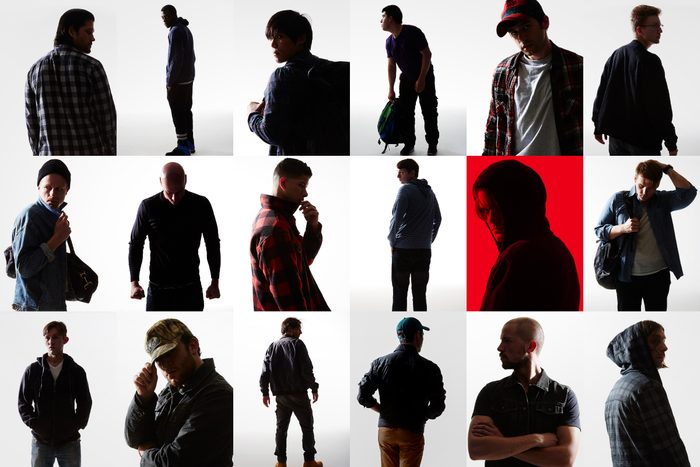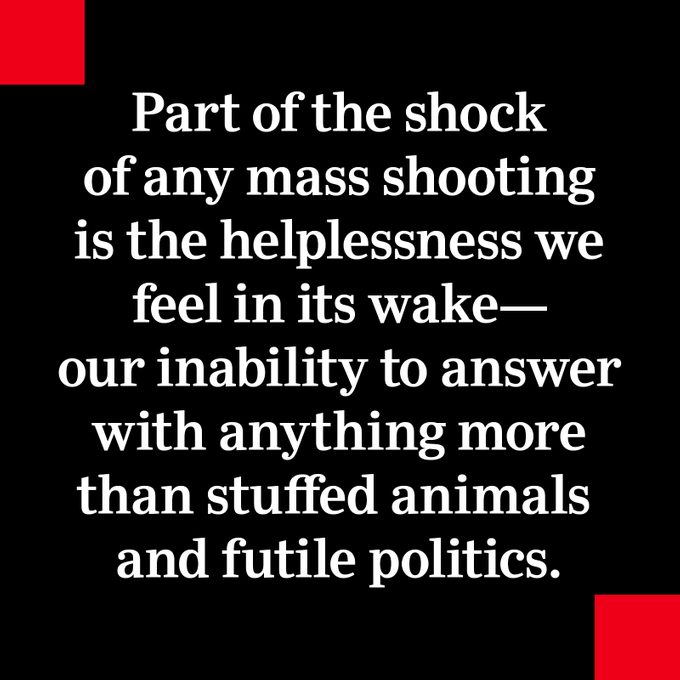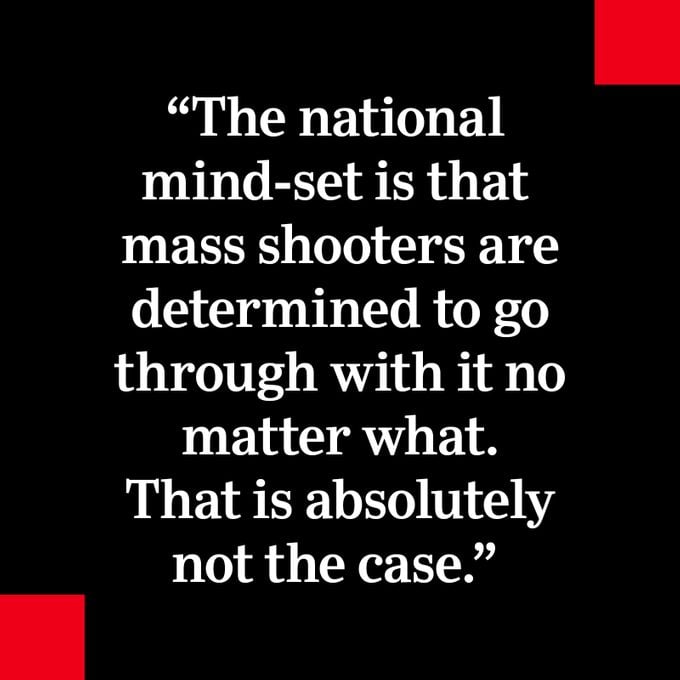Ex-Gunman Tells Us How to Stop the Next Mass Shooter
Updated: Jul. 06, 2022

An eye-opening look into the minds of mass shooters—from a wannabe killer who was arrested just in the nick of time.
Nobody knows who he is, and nobody knows who he was. When he was a young man, his anonymity fueled his desperation, and for a short time, his desperation made him known. He was well-known enough to think that when he came home after eight and a half years in prison, there might be cameras waiting on his front lawn. There weren’t. There was just his family and the rest of his life.
So Trunk—a nickname he acquired when he went away—couldn’t be more anonymous. He works hard at his college studies, and his academic record is immaculate. He has ambitions. He has friends. He does not mind being anonymous or feeling alone, because he feels accepted and has accepted himself.
Trunk does, however, think often of the person who is out there right now feeling the way he used to feel. The person with a grievance. The person with a plan. The person with a gun—or an arsenal. The person we feel powerless against because we don’t know who he is. All we know is what he—or she—is going to do.
Mass shootings have become a feature of American life, and we know very well what follows each one: the shock, the horror, the demonization of the guilty, the prayers for the innocent, the calls for action, the finger-pointing, the paralysis, and finally, the forgetting. Here are eye-opening statistics about gun violence in America. We are so convinced the shootings can’t be stopped that we don’t even know if anyone is trying to stop them. And we are so convinced the evil they represent is inexplicable that we don’t try to explicate it.
But we are wrong: Mass shootings are not unstoppable, and there are people trying to stop them. They are not inexplicable, because every time Trunk hears of one, he understands why it happened and who did it. Trunk was almost one of them.
Trying to stop the next school shooting
The outside of the building is nondescript by design. In an anonymous conference room inside the anonymous building, a man named Andre Simons sits at the head of the table. He is trim, compact, and alert, with a scalp shaved to a high shine, arched eyebrows, and preternaturally wide-open eyes. And he is the answer to the question of who is trying to stop the next shooting (most school shooters share these traits).
Within the FBI is the National Center for the Analysis of Violent Crime, and within the NCAVC, there are the behavioral-analysis units, made famous by movies and TV for profiling serial killers. Simons is in charge of Behavioral Analysis Unit 2, which assesses threats. “Threat assessment” is a formal discipline—practitioners have their own professional organization and journal. And even though very few people know what it is, threat assessment is our country’s response to mass shootings, with Simons foremost among the federal officials trying to implement it on a national level.
Part of the shock of any mass shooting is the helplessness we feel in its wake—our inability to answer with anything more than stuffed animals and futile politics. When you start researching the question of what the United States is doing to stop mass shootings, what’s remarkable is the degree to which the arena has been turned over to the people who do threat assessment. Threat assessment is not just the best we’ve got; it’s all we’ve got.
Trunk, now 34, could be anyone from anywhere. When you look at him, you see somebody’s son; when you look again, you see a photo on the front page of the paper. He could be both. He has been both. Almost 15 years ago, he was arrested with a military-grade rifle slung on his back, a pistol in his belt, a machete, and 2,000 rounds of ammunition. He was dressed in black, and so were his two armed accomplices. To avoid charges of conspiracy and weapons possession, he pleaded guilty to carjacking and received a ten-year sentence. In prison, he had a nickname: Trunk Full of Guns.

Prison is, in his opinion, what saved him. “I was forced to learn social skills in jail. I’d never had the experience of talking to other people. In jail, I had no choice. If you don’t know how to talk to people, you get crushed.”
He also became reflective, especially when the prison TV showed the latest shooter. He knew shooters—he knew what they had gone through because of what he had gone through. So when he got an email asking if he had ideas about stopping shootings, he volunteered to talk, if only so that others might assess the threat—and yes, the humanity—of people like him.
It started with a thought, Trunk says. “I’d be lying in bed wondering what I was doing wrong. Why didn’t anybody like me? … So I started thinking they were losers. I started thinking that they didn’t like me because they were afraid of me—because I had power and they didn’t. Because I was special. And that’s when it all really got started: when I began thinking I was special.”
Mass shooters have supplanted serial killers and possibly terrorists as a symbol of ultimate evil. Since 9/11, there have been 20 lethal terrorist attacks in the United States, resulting in the deaths of 46 people. According to USA Today, there have been more than 346 mass shootings (incidents in which four or more people are killed) since 1999, with some 15 percent described as “public” shootings—stranger to stranger. More than 1,700 people have died; many more have been wounded. What America feared after the 9/11 attacks—that it would be perpetually attacked by outsiders calling themselves Americans—finally has transpired, only with an awful twist: It is perpetually attacked by Americans who call themselves outsiders.
Mass shootings are like terrorism in that they are meant to terrorize. But that doesn’t mean shooters can be investigated as terrorists. For one thing, “the active shooter,” says Simons, “tends more often than not to be motivated by a deeply personal grievance tinged with feelings of persecution and humiliation, real and perceived, whereas terrorists are oftentimes going to be motivated by more ideological reasons.” For another, mass shooters are almost always American citizens.
Waiting for a concerned person to speak up
When Simons is asked what his team does, he talks about what it doesn’t do. “We don’t do behavioral checklists. We don’t do stings. We are not proactively scraping the Internet for offenders.… We react.” Instead, the agents depend on what Simons calls “the human bystander.” They depend on somebody giving someone else the creeps. Though he acknowledges that many bystanders are fragile resources—“it’s usually the people closest to an individual who are best positioned to observe those kinds of concerning behaviors, and at the same time the most reluctant to report”—his team members have no choice but to wait for a concerned person to tell them about a person of concern.
We think of perpetrators of targeted violence as psychopaths—isolated, motivated, and conscienceless—or troubled individuals who “just snap.” According to the tenets of threat assessment, they are neither. “The people who carry out these attacks typically do them out of a sense of desperation,” says Marisa Randazzo, a former Secret Service chief psychologist who is a managing partner at Sigma Threat Management Associates. “They typically have been of concern to people who know them for long periods of time. And when we did interviews with school shooters, they expressed a level of ambivalence that surprised me. Part of them felt they had to go through with it; part of them felt they didn’t want to at all. Part of them looked for encouragement; part of them looked for someone to stop them. The national mind-set is that they’re determined to go through with it no matter what. That is absolutely not the case.”
When he got out of prison, Trunk went home and found his high school yearbook. He was shocked. His classmates had signed it. Girls had given him their numbers. He hadn’t been voted “Biggest Loser” but rather “Most Bashful.” Bashful? “I was like, When did this happen? They were trying to reach out to me, but I couldn’t see it.”

During his last year in high school, his mind kept telling him that he was an outcast, and he withdrew. “It was me against the world,” he says. All he needed was another outcast to hang out with. He found one in a friend of his younger brother. They thought the same way: They were special, and everyone else was ordinary. They played a lot of video games “about people who are special rising over everyone else to save the world.”
People have blamed video games for inciting violence. “Video games just go with the territory,” Trunk says. “Like writing in a journal. No journal ever caused a shooting. It’s just part of the landscape. It’s a symptom.”
The guns were another matter. Or, how the guns fueled his thinking. There were 14 of them in a locked closet, a few feet away. One of his earliest memories was of his father sitting on his couch cleaning his guns. His father was a member of the NRA and believed in the God-given right to bear arms. But what did that mean to a boy like him? It meant that God wanted him to have a gun. It meant that deep down, he was a warrior.
Trunk never shot guns when he was a kid. He wasn’t interested—until he joined forces with another outcast. Then he opened the closet. And there was power. It is the part of his story he wants to make sure people know: “If there were no guns in the picture, it wouldn’t have happened the way it did.” Wouldn’t he have gotten weapons in any way he could?
It was July 6. “We picked the Fourth of July weekend so none of the parents would be home,” Trunk says. “When we were loading [our weapons], I was so high-strung, but at the same time, I was so somber, as if our dog had just died. Not because we thought we were going to die—we all thought we were going to survive it; that shows how detached I was from the situation. But it felt like I was going to a job I hated. I would have loved to have been doing anything else. It was all rote; it was all just going through the motions.”
He uses the fact that they went out in the wee hours of the morning to argue that their intent was not murderous. He contends that what prosecutors alleged—that they’d targeted three classmates and then wanted to kill as many people as possible—was never the plan. “Come on—it was three in the morning, and we tried to hijack a car. None of us could drive. That just shows how unrealistic we were. When the carjacking didn’t work”—when the victim sped off—“we were already in abort. We were on our way back to my house when the cop stopped us. I had never seen someone do a real double take before, like in a cartoon.… He had stopped three people dressed in black trench coats and armed with guns and machetes. He jumped behind the door of his car and told us to drop them. I saw that he was shaking. I kept thinking that he must have a family. I was like, ‘I don’t want to be the bad guy.’ I still thought of myself as a decent person.… I told the others to drop their weapons. They were flabbergasted. We had commands. We’d developed hand signs, and I gave them the sign to stand down. And that was it.”
Practicing threat assessment
What brought the person to your attention? Does the person harbor a grievance or carry a grudge? Has the person communicated an intent to attack? Has the person written anything, anywhere, about his or her intentions and ideas? Has the person shown an interest in other attacks or other attackers? In assassins? In mass murders? In terror or terrorists? In weapons? Has the person developed a plan? Has the person acquired weapons?
These are some of the questions that experts like Simons have developed for the purpose of assessing threats. But the hard part is what to do when the questions identify a person as a threat. Most of the time, he—and odds are, it will be a male, although female attackers exist—cannot be charged, because he hasn’t committed a crime. He also can’t be committed, because he doesn’t represent an imminent risk to himself or others. He falls into what law-enforcement officials tend to call “the gap,” the place between knowing that a person represents a threat and knowing what to do about it.
Threat assessment was meant to address the gap. At the end of 2013, then–attorney general Eric Holder credited Simons’s unit with preventing 148 mass shootings and violent attacks, a figure that Simons has had to defend ever since. “Our success will always be hard to quantify, since success is defined as the lack of an event. But none of the cases we have supported have gone on to do a mass shooting or a mass event,” he says.
Simons has never prevented a shooting in the way that might reassure us most—he has never predicted an attack and then shown up with his guns blazing. He says he has had a hand in interventions involving men and women on pathways that might have ended in mass shootings and has done this at least 500 times since 2010. But he has also had to show up six times at scenes of primal horror—where mass shootings had taken place.
“Have you recently acquired a weapon?”
On April 30, 2014, deputies from the sheriff’s office in Santa Barbara County, California, went to the apartment of Elliot Rodger, a 22-year-old college dropout. They were making a “check the welfare” visit because of a call they had received from Rodger’s “social counselor”—an acquaintance hired to help Rodger fit in. The counselor had spoken up because of a call he received from Rodger’s mother. And his mother had called because she had seen a video her son had posted on YouTube and intuited that he was on the pathway to violence.
None of this is news. A month later, Rodger accomplished his “Day of Retribution,” when he attacked and killed six people, and the April 30 call became infamous as a missed opportunity. “So what do you expect them to do? They go there, he looks normal, he acts normal,” says former New York City police commissioner Ray Kelly. “People ask why they didn’t search the house.… He’d have to give consent. And you couldn’t get a search warrant. It was a wellness check, OK?”
The visit demonstrates the fecklessness of law enforcement in the face of someone planning a mass shooting, even when law enforcement stares a mass shooter in the face. What else could the deputies have done? They could have watched the videos that had elicited concern and asked about them. They could have asked to come inside. And they could have asked the question that indicates more than anything else a person’s evolution into a person of concern: “Have you recently acquired a weapon?”
Rodger had recently bought three. It didn’t matter that they were legal or that he had the right to them. The great advantage of threat assessment is that it renders those considerations irrelevant. It understands that guns are intrinsic to violence. But the Santa Barbara deputies didn’t ask.
According to the sheriff’s spokeswoman, Kelly Hoover, “the issue of weapons did not come up.” She adds, “We have a threat-assessment team, but they weren’t assigned to the welfare check. However, all California law-enforcement officers receive some basic training in threat assessment.”
If Elliot Rodger had been a Pakistani immigrant, would the deputies have left his apartment without asking basic questions? For better or for worse, the prospect of terror creates investigatory obligations that the vague possibility of a mass shooting simply does not.
It is fitting, then, that Simons’s Behavioral Analysis Unit 2 is down the hall from Behavioral Analysis Unit 1: counterterrorism. They work closely together. The difference is that BAU1 works with the U.S. Department of Homeland Security and the Joint Terrorism Task Force, and BAU2 works with local law enforcement and is under-financed and under-resourced. Simons has only 10 agents.
Trunk wishes he could have spoken to Rodger before the shooting. “I can see exactly where he was coming from—the reasoning behind it. If you’ve ever been on the side of the fence where you are an outcast, it hurts. Why me? Why do they get to have all the fun?… He wanted so much to be accepted, he was willing to kill other people. That means I know he had nights when he cried himself to sleep and prayed to God, whether he believed in God or not.
“I read my journals [from] before the night we went out. It was all ‘If only’—‘if only I could go out with this girl, join this team, go out to this place.’ I wanted attention. If someone would have come up to me and said, ‘You don’t have to do this, you don’t have to have this strange strength, we accept you,’ I would have broken down and given up.”
A poster child for threat assessment
In many ways, Trunk could be a poster child for threat assessment. He followed a pathway to violence—or to averted violence—that was almost exactly in accord with the one charted by people like Simons. A threat-assessment team could have intervened before he had to begin his life as Trunk Full of Guns. But no one came near him—no teacher, no school psychologist, no parent. The threat that he presented remained unassessed.
“The best chance for [a potential shooter] to be stopped is for him to be connected to an institution that has a threat-assessment protocol already in place,” says Michelle Keeney of the National Threat Assessment Center.
“What these people need,” says Simons, “are alternatives to violence. They are often unable or unwilling to articulate to themselves that there are alternatives to violence. They have shut that door. Our job is to open other doors for them so that they don’t go through the last door they think they have left.”
At this very moment in America, someone is arming himself and planning to kill as many people as possible. That is a matter of certainty. Can he be stopped? Yes—but that is almost a matter of faith. He can be stopped if he can be identified. He can be stopped if he can be assessed. He can be stopped if he can be managed. He can be stopped if Andre Simons and Trunk get what they want—if someone sees him, notices him, and wonders who he is and what he’s doing.


